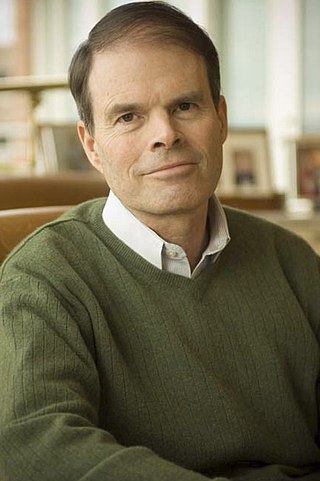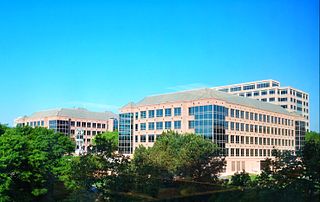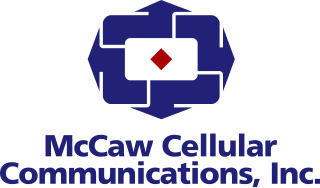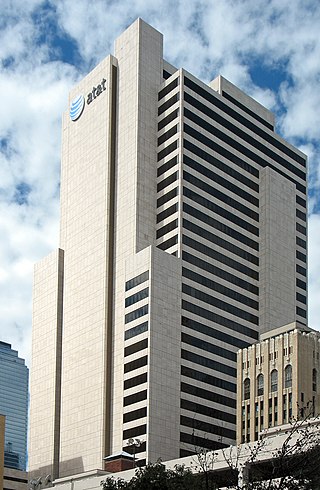
A Regional Bell Operating Company (RBOC) was a corporate entity created as result of the antitrust lawsuit by the U.S. Department of Justice against the American Telephone and Telegraph Company (AT&T) in 1974 and settled in the Modification of Final Judgment on January 8, 1982.

BellSouth, LLC was an American telecommunications holding company based in Atlanta, Georgia. BellSouth was one of the seven original Regional Bell Operating Companies after the U.S. Department of Justice forced the American Telephone & Telegraph Company to divest itself of its regional telephone companies on January 1, 1984.

Craig McCaw is an American businessman and entrepreneur, a pioneer in the cellular phone industry. He is the founder of McCaw Cellular and Clearwire Corporation.

AT&T Mobility, LLC, also known as AT&T Wireless and marketed as simply AT&T, is an American telecommunications company. It is a wholly owned subsidiary of AT&T Inc. and provides wireless services in the United States. AT&T Mobility is the largest wireless carrier in the United States, with 222.8 million subscribers at the end of Q1 2023.
Verizon is an American wireless network operator that previously operated as a separate division of Verizon Communications under the name Verizon Wireless. In a 2019 reorganization, Verizon moved the wireless products and services into the divisions Verizon Consumer and Verizon Business, and stopped using the Verizon Wireless name. Verizon is the second-largest wireless carrier in the United States, with 143.3 million subscribers at the end of Q2 2023.

Altafiber, Inc., formerly Cincinnati Bell, is a regional telecommunications service provider based in Cincinnati, Ohio, United States. It provides landline telephone, fiber-optic Internet, and IPTV services through its subsidiaries Altafiber Home Phone and Hawaiian Telcom, which are the incumbent local exchange carriers for the Greater Cincinnati metropolitan area and Hawaii. Other subsidiaries provide enterprise information technology services and long distance calling.
Rogers Wireless Inc. is a Canadian wireless telephone company headquartered in Toronto, providing service nationally throughout Canada. It is a wholly owned subsidiary of Rogers Communications. The company had revenues of just under $15.1 billion in 2018. Rogers Wireless is the largest wireless carrier in Canada, with 13.7 million subscribers as of Q2 2023.
Houston Cellular was a Houston-based cell phone company which provided AMPS and D-AMPS (TDMA) service in the Greater Houston area. It was formed in 1983 and was operated as a partnership between LIN Broadcasting Corp., Mobile Communication Corp. of America and BellSouth Co. Its headquarters were located in Houston, Texas.
Cellular One is the trademarked brand name that licenses services used by several cellular service providers in the United States. The brand was sold to Trilogy Partners by AT&T in 2008 shortly after AT&T had completed its acquisition of Dobson Communications. Cellular One was originally the trade name of one of the first mobile telephone service providers.

Alltel was a landline, wireless and general telecommunications services provider, primarily based in the United States. Before its wireless division was acquired by Verizon Wireless and AT&T, Alltel provided cellular service to 34 states and had approximately 13 million subscribers. As a regulatory condition of the acquisition by Verizon, a small portion of Alltel was spun off and continued to operate under the same name in six states, mostly in rural areas. Following the merger, Alltel remained the ninth largest wireless telecommunications company in the United States, with approximately 800,000 customers. On January 22, 2013, AT&T announced they were acquiring what remained of Alltel from Atlantic Tele-Network for $780 million in cash.

AirTouch Communications was an American wireless telephone service provider, created as a spin-off on Pacific Telesis on April 1, 1994. Its headquarters were in One California in the Financial District, San Francisco, California. After a series of mergers, the company's vestiges are now part of Verizon Wireless.
Ameritech Mobile Communications, LLC was the first company in the United States to provide cellular mobile phone service to the general public. Cell service became publicly available in Chicago on October 13, 1983. The company was a division of Ameritech which, as of January 1, 1984, was the holding company of Illinois Bell, Michigan Bell, Wisconsin Bell, Ohio Bell, and Indiana Bell, which provides landline service to the Great Lakes region. From around 1986, Cincinnati Bell held a 45% stake in the company. Originally named Ameritech Mobile Communications, it later became known as Ameritech Cellular.

SunCom Wireless Holdings, Inc. was a wireless carrier that operated in the Southeastern United States since 1999 and in parts of the Caribbean since 2004. From the "About Us" section of the company's website:

McCaw Cellular Communications was a cellular telephone pioneer in the United States. Savvy licensing of cellular spectrum in the early 1980s put McCaw Cellular in an extremely strong position, quickly outpacing the growth of the "Baby Bells" in the emerging market. The company purchased MCI Communications's mobile businesses in 1986, followed by LIN Broadcasting in 1989, giving them widespread access in all of the major US markets. Partnering with AT&T as a technology provider, McCaw introduced their "Cellular One" service in 1990, the first truly national cellular system. AT&T purchased 33% of the company in 1992, and arranged a merger in 1994 that made Craig McCaw one of AT&T's largest shareholders. In 2002, the company was spun off from AT&T to become AT&T Wireless Services.
Advanced Mobile Phone Service, Inc. was a subsidiary of AT&T prior to the Bell System Divestiture. Abbreviated AMPS, the company was created in 1978 to build and operate the new Advanced Mobile Phone System, also abbreviated AMPS. AMPS was developed by Bell Labs to replace older, severely limited radiophone services, such as IMTS. AMPS was one of the first modern cellular phone systems, which remained in operation until 2008.

Nextel Communications, Inc. was an American wireless service operator that merged with and ceased to exist as a subsidiary of Sprint Corporation, which would later be bought by T-Mobile US and folded into that company. Nextel in Brazil, and formerly in Argentina, Chile, Peru, the Philippines, and Mexico, is part of NII Holdings, a stand-alone, publicly traded company not owned by Sprint Corporation.

AT&T Inc. is an American multinational telecommunications holding company headquartered at Whitacre Tower in Downtown Dallas, Texas. It is the world's fourth-largest telecommunications company by revenue and the largest wireless carrier in the United States. As of 2023, AT&T was ranked 13th on the Fortune 500 rankings of the largest United States corporations, with revenues of $120.7 billion. It is currently recognized as the top entry-level employer in Dallas.
The history of AT&T dates back to the invention of the telephone. The Bell Telephone Company was established in 1877 by Alexander Graham Bell, who obtained the first US patent for the telephone, and his father-in-law, Gardiner Greene Hubbard. Bell and Hubbard also established American Telephone and Telegraph Company in 1885, which acquired the Bell Telephone Company and became the primary telephone company in the United States. This company maintained an effective monopoly on local telephone service in the United States until anti-trust regulators agreed to allow AT&T to retain Western Electric and enter general trades computer manufacture and sales in return for its offer to split the Bell System by divesting itself of ownership of the Bell Operating Companies in 1982.

AT&T Mexico, also known as AT&T Mexico Wireless and AT&T Mexico Mobility, is a Mexican mobile telephone operator and subsidiary of AT&T. AT&T Mexico is headquartered in Mexico City. Its mobile network is available in 90% of Mexico, serving 13% of the Mexican wireless market. AT&T is the third-largest wireless carrier in Mexico, with 21.603 million subscribers as of December 2022.












